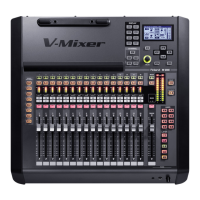
 Loading...
Loading...
Do you have a question about the Roland M-200i V-mixer and is the answer not in the manual?
| Type | Digital Mixer |
|---|---|
| Output Channels | 18 |
| Effects | Yes |
| Computer Connectivity | USB |
| iPad Control | Yes |
| USB Audio Interface | Yes |
| Sampling Rate | 48 kHz |
| Bit Depth | 24-bit |
| EQ Bands per Channel | 4 |
| Faders Type | Motorized |
| Built-in Wi-Fi | Yes |
| Inputs - Mic | 16 |
| Outputs - Main | 2 (stereo) |
| Outputs - Other | 8 |
| EQ Bands | 4-band |
Lists all items included with the M-200i and explains the fundamentals of the REAC interface.
Details AC power connection procedures, safety, and information on the internal battery.
Identifies and describes controls and connectors on the top, front, and rear panels.
Details the CHANNEL EDIT and Screen controller sections for operational control.
Covers general panel operations, screen navigation, and channel layer selection.
How to copy and paste channel settings using the clipboard.
Overview of library functions for storing and recalling settings.
Explains input channel functions, signal flow, and accessing the CHANNEL EDIT screen.
Explains GATE, COMP functions for dynamics, and the 4-band EQ.
How to link adjacent channels for stereo operation.
Overview of programmable effects, GEQ, and inserting external devices.
How to insert effects into channels and edit GEQ parameters.
Explains the scene memory function for storing mixer parameters.
How to save current mixer settings as scenes and load them.
Overview of the two-track recorder function using USB memory.
Steps for starting and stopping recording to USB memory.
Steps to access SETUP, save, and load mixer settings.
How to reset settings to factory defaults and calibrate faders.
Explains advanced REAC usage, splitting, and connection settings.
Covers LAN and WIRELESS LAN settings for remote control.
Details remote control via MIDI, RS-232C, USB MIDI, and V-LINK.
Steps to access the SYSTEM screen and its sub-menus.
Adjusting display brightness and calibrating faders.
Provides solutions for common operational problems and error messages.
Lists technical specifications and physical dimensions of the M-200i.